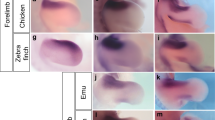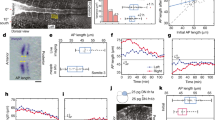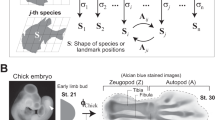Abstract
THE polar coordinate model of French et al.1, commonly called the clockface model, is a concept of great significance to developmental biology, as it presents a unified view of pattern regulation in Drosophila imaginal disks and insect and amphibian limbs. By postulating two rules, intercalation by the shortest route and the complete circle rule for distal transformation, the production of supernumerary limbs in insects2–5 and amphibians6,7 after axial reversal is elegantly explained. Following 180° rotation, the insect limb can produce two supernumeraries in various positions2–4, whereas in the newt the extra limbs are in constant circumferential positions8. Because a complete circle is needed for distal transformation, the model clearly predicts that at no other angle of ipsilateral rotation apart from 180° will supernumeraries be induced. However, Wallace (personal communication), the first to test such a prediction on amphibian limbs, has demonstrated that after 90° or 270° rotation, supernumerary limbs are produced. We report here that, unlike newts and more like insects, axolotls can produce supernumerary limbs anywhere on the circumference after 180° rotation of blastemas. In addition, supernumeraries can be produced at a variety of angles of rotation between 45° and 315°. This work calls for a reappraisal, at least in axolotls, of the clockface model.
This is a preview of subscription content, access via your institution
Access options
Subscribe to this journal
Receive 51 print issues and online access
$199.00 per year
only $3.90 per issue
Buy this article
- Purchase on Springer Link
- Instant access to full article PDF
Prices may be subject to local taxes which are calculated during checkout
Similar content being viewed by others
References
French, V., Bryant, P. J. & Bryant, S. V. Science 193, 969–981 (1976).
Bohn, H. Wilhelm Roux Arch. EntwMech. Org. 156, 449–503 (1965).
Bohn, H. J. Embryol. exp. Morph. 28, 185–208 (1972).
Bulliere, D. J. Embryol. exp. Morph. 23, 337–357 (1970).
French, V. J. Embryol. exp. Morph. 35, 267–301 (1976).
Iten, L. E. & Bryant, S. V. Devl Biol. 44, 119–147 (1975).
Tank, P. W. Devl Biol. 62, 143–161 (1978).
Bryant, S. V. & Iten, L. E. Devl Biol. 50, 212–234 (1976).
Tank, P. W., Carlson, B. M. & Connelly, T. G. J. Morph. 150, 117–128 (1976).
Slack, J. M. W. Nature 271, 760–761 (1978).
Bryant, S. V. Nature 263, 676–679 (1976).
Goodwin, B. C. in Analytical Physiology of Cells and Developing Organisms (Academic, London, 1976).
Slack, J. M. W. J. Embryol. exp. Morph. 39, 169–182 (1977).
Author information
Authors and Affiliations
Rights and permissions
About this article
Cite this article
MADEN, M., TURNER, R. Supernumerary limbs in the axolotl. Nature 273, 232–235 (1978). https://doi.org/10.1038/273232a0
Received:
Accepted:
Issue Date:
DOI: https://doi.org/10.1038/273232a0
This article is cited by
-
Structure of supernumerary limbs
Nature (1980)
-
Chemical patterns in circular morphogenetic fields
Bulletin of Mathematical Biology (1979)
Comments
By submitting a comment you agree to abide by our Terms and Community Guidelines. If you find something abusive or that does not comply with our terms or guidelines please flag it as inappropriate.



